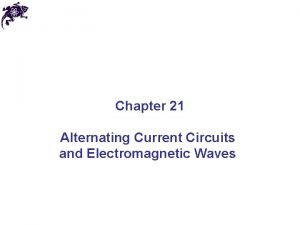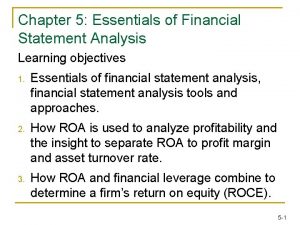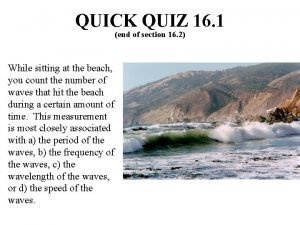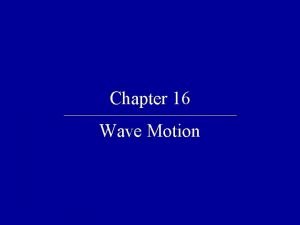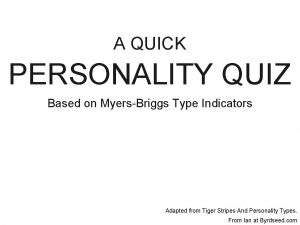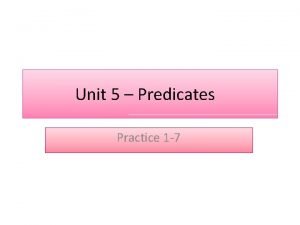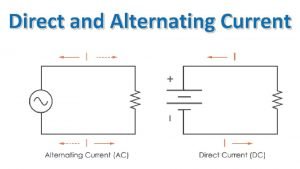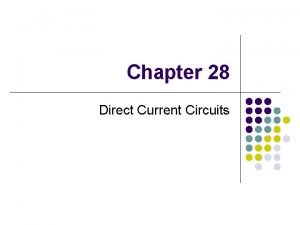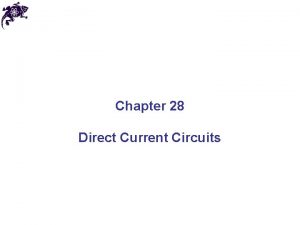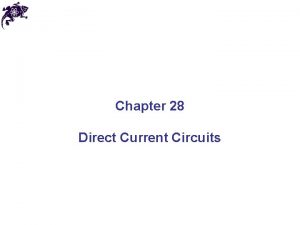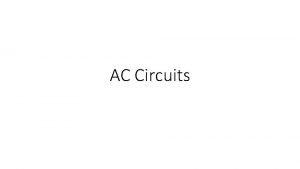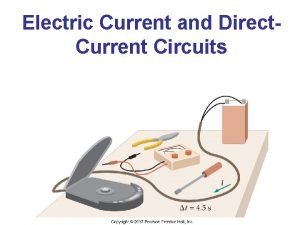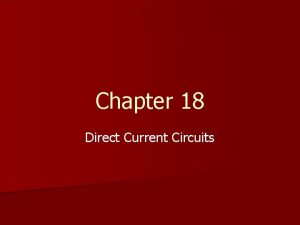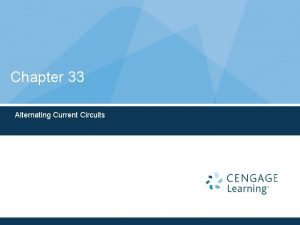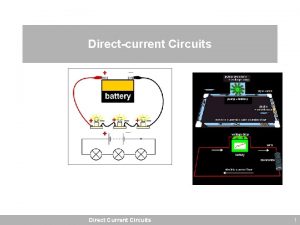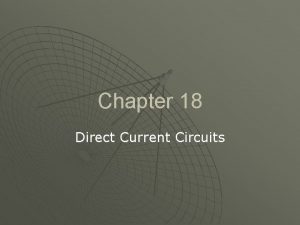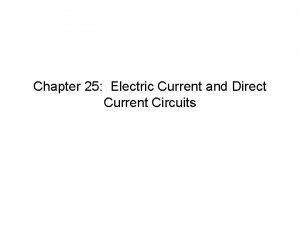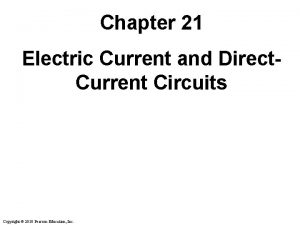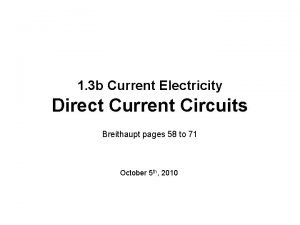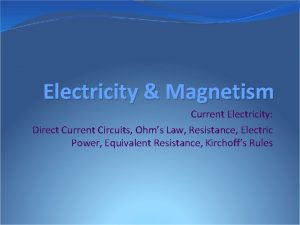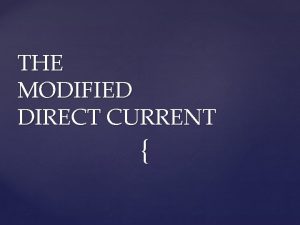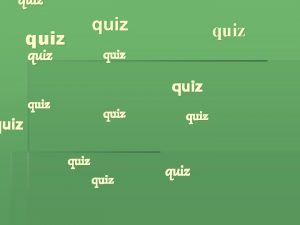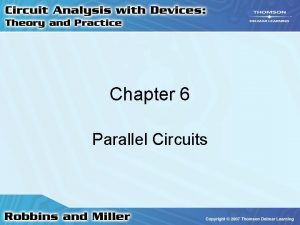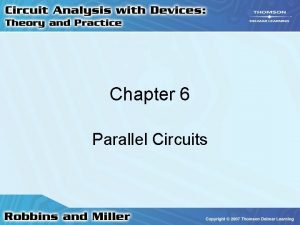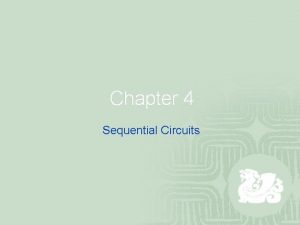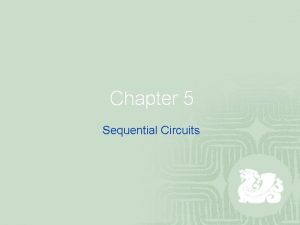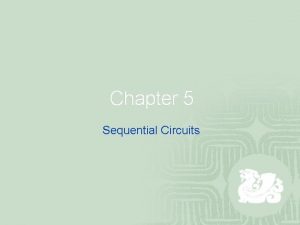Chapter 28 Direct Current Circuits Quick Quiz 28





























- Slides: 29

Chapter 28 Direct Current Circuits

Quick Quiz 28. 1 In order to maximize the percentage of the power that is delivered from a battery to a device, the internal resistance of the battery should be (a) as low as possible (b) as high as possible (c) The percentage does not depend on the internal resistance.

Quick Quiz 28. 1 Answer: (a). Power is delivered to the internal resistance of a battery, so decreasing the internal resistance will decrease this “lost” power and increase the percentage of the power delivered to the device.

Quick Quiz 28. 2 In the figure below, imagine positive charges pass first through R 1 and then through R 2. Compared to the current in R 1, the current in R 2 is (a) smaller (b) larger (c) the same

Quick Quiz 28. 2 Answer: (c). In a series circuit, the current is the same in all resistors in series. Current is not “used up” as charges pass through a resistor.

Quick Quiz 28. 3 If a piece of wire is used to connect points b and c in Figure 28. 4 b, the brightness of bulb R 1 will (a) increase (b) decrease (c) remain the same

Quick Quiz 28. 3 Answer: (a). Connecting b to c “shorts out” bulb R 2 and changes the total resistance of the circuit from R 1 + R 2 to just R 1. Because the resistance of the circuit has decreased (and the emf supplied by the battery does not change), the current in the circuit increases.

Quick Quiz 28. 4 With the switch in this circuit closed (left), there is no current in R 2, because the current has an alternate zero-resistance path through the switch. There is current in R 1 and this current is measured with the ammeter (a device for measuring current) at the right side of the circuit. If the switch is opened (Fig. 28. 5, right), there is current in R 2. What happens to the reading on the ammeter when the switch is opened? (a) the reading goes up (b) the reading goes down (c) the reading does not change

Quick Quiz 28. 4 Answer: (b). When the switch is opened, resistors R 1 and R 2 are in series, so that the total circuit resistance is larger than when the switch was closed. As a result, the current decreases.

Quick Quiz 28. 5 a In this figure, imagine that we add a third resistor in series with the first two. The current in the battery will: (a) increase (b) decrease (c) remain the same

Quick Quiz 28. 5 a Answer: (b). Adding another series resistor increases the total resistance of the circuit and thus reduces the current in the circuit.

Quick Quiz 28. 5 b In the same figure, imagine that we add a third resistor in series with the first two. The terminal voltage of the battery will (a) increase (b) decrease (c) remain the same

Quick Quiz 28. 5 b Answer: (a). The potential difference across the battery terminals increases because the reduced current results in a smaller voltage decrease across the internal resistance.

Quick Quiz 28. 6 a In the figure below, imagine that we add a third resistor in parallel with the first two. The current in the battery will: (a) increase (b) decrease (c) remain the same

Quick Quiz 28. 6 a Answer: (a). If the second resistor were connected in parallel, the total resistance of the circuit would decrease, and the current in the battery would increase.

Quick Quiz 28. 6 b In the same figure, imagine that we add a third resistor in parallel with the first two. The terminal voltage of the battery will: (a) increase (b) decrease (c) remain the same

Quick Quiz 28. 6 b Answer: (b). The potential difference across the terminals would decrease because the increased current results in a greater voltage drop across the internal resistance.

Quick Quiz 28. 7 With the switch in the following circuit open (left), there is no current in R 2. There is current in R 1 and this current is measured with the ammeter at the right side of the circuit. If the switch is closed (right), there is current in R 2. What happens to the reading on the ammeter when the switch is closed? (a) the reading goes up (b) the reading goes down (c) the reading does not change

Quick Quiz 28. 7 Answer: (a). When the switch is closed, resistors R 1 and R 2 are in parallel, so that the total circuit resistance is smaller than when the switch was open. As a result, the current increases.

Quick Quiz 28. 8 In using Kirchhoff’s rules, you generally assign a separate unknown current to (a) each resistor in the circuit (b) each loop in the circuit (c) each branch in the circuit (d) each battery in the circuit

Quick Quiz 28. 8 Answer: (c). A current is assigned to a given branch of a circuit. There may be multiple resistors and batteries in a given branch.

Quick Quiz 28. 9 a Consider the circuit seen below and assume that the battery has no internal resistance. Just after the switch is closed, the potential difference across which of the following is equal to the emf of the battery? (a) C (b) R (c) neither C nor R.

Quick Quiz 28. 9 a Answer: (b). Just after the switch is closed, there is no charge on the capacitor, so there is no voltage across it. Charges begin to flow in the circuit to charge up the capacitor, so that all of the voltage ΔV = IR appears across the resistor.

Quick Quiz 28. 9 b After a very long time, the potential difference across which of the following is equal to the emf of the battery? (a) C (b) R (c) neither C nor R

Quick Quiz 28. 9 b Answer: (a). After a long time, the capacitor is fully charged and the current drops to zero. Thus, the battery voltage is now entirely across the capacitor.

Quick Quiz 28. 10 a Consider the circuit in the figure below and assume that the battery has no internal resistance. Just after the switch is closed, the current in the battery is (a) zero (b) ε/2 R (c) 2ε /R (d) ε/R (e) impossible to determine.

Quick Quiz 28. 10 a Answer: (c). Just after the switch is closed, there is no charge on the capacitor. Current exists in both branches of the circuit as the capacitor begins to charge, so the right half of the circuit is equivalent to two resistances R in parallel for an equivalent resistance of 1/2 R.

Quick Quiz 28. 10 b After a very long time, the current in the battery is (a) zero (b) ε/2 R (c) 2ε/R (d) ε /R (e) impossible to determine.

Quick Quiz 28. 10 b Answer: (d). After a long time, the capacitor is fully charged and the current in the right-hand branch drops to zero. Now, current exists only in a resistance R across the battery.
 Series parallel circuit current
Series parallel circuit current Quick find algorithm
Quick find algorithm Collision forces quick check
Collision forces quick check Circuits-current worksheet answers
Circuits-current worksheet answers Alternating current circuits and electromagnetic waves
Alternating current circuits and electromagnetic waves Current ratio and quick ratio
Current ratio and quick ratio Quick quiz 16 answers
Quick quiz 16 answers Quick quiz 16 answers
Quick quiz 16 answers Quick personality quiz
Quick personality quiz Unit 5 quick quiz 1
Unit 5 quick quiz 1 Y connected generator
Y connected generator Line vs phase voltage
Line vs phase voltage Drift current and diffusion current
Drift current and diffusion current Ac theory 3 lesson 4
Ac theory 3 lesson 4 Drift current
Drift current Drift current and diffusion current
Drift current and diffusion current Drain current in the constant-current region increases when
Drain current in the constant-current region increases when Balanced wye-wye connection
Balanced wye-wye connection Infineon
Infineon Drift current and diffusion current in semiconductor
Drift current and diffusion current in semiconductor The shielded metal arc welding machines voltage output
The shielded metal arc welding machines voltage output Touch current vs leakage current
Touch current vs leakage current Kcl mesh analysis
Kcl mesh analysis Current and future trends of media and information quiz
Current and future trends of media and information quiz Weekly current events quiz
Weekly current events quiz Simon conway current affairs quiz
Simon conway current affairs quiz Weekly current events quiz
Weekly current events quiz Ac dc graph
Ac dc graph Alternating current
Alternating current Alternating current
Alternating current




